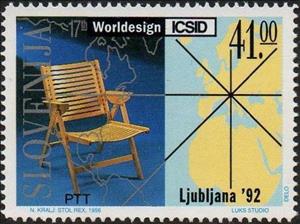Stamp: 17 th Worldesign ICSID (Slovenia 1992)
17 th Worldesign ICSID (Slovenia 1992)
17 May (Slovenia ) within release Art goes into circulation Stamp 17 th Worldesign ICSID face value 41 Slovenian tolar
| Stamp 17 th Worldesign ICSID in catalogues | |
|---|---|
| Michel: | Mi:SI 22 |
| Yvert et Tellier: | Yt:SI 22 |
Stamp is horizontal format.
Also in the issue Art:
- Stamp - 17 th Worldesign ICSID face value 41;
- First Day Cover - 17th International Congress of Industrial Design - ICSID face value 41;
Stamp 17 th Worldesign ICSID it reflects the thematic directions:
Art is a diverse range of human activities in creating visual, auditory or performing artifacts (artworks), expressing the author's imaginative or technical skill, intended to be appreciated for their beauty or emotional power. In their most general form these activities include the production of works of art, the criticism of art, the study of the history of art, and the aesthetic dissemination of art. The oldest documented forms of art are visual arts, which include creation of images or objects in fields including painting, sculpture, printmaking, photography, and other visual media. Architecture is often included as one of the visual arts; however, like the decorative arts, or advertising, it involves the creation of objects where the practical considerations of use are essential—in a way that they usually are not in a painting, for example. Music, theatre, film, dance, and other performing arts, as well as literature and other media such as interactive media, are included in a broader definition of art or the arts. Until the 17th century, art referred to any skill or mastery and was not differentiated from crafts or sciences. In modern usage after the 17th century, where aesthetic considerations are paramount, the fine arts are separated and distinguished from acquired skills in general, such as the decorative or applied arts.
Furniture refers to objects intended to support various human activities such as seating (e.g., stools, chairs, and sofas), eating (tables), storing items, working, and sleeping (e.g., beds and hammocks). Furniture is also used to hold objects at a convenient height for work (as horizontal surfaces above the ground, such as tables and desks), or to store things (e.g., cupboards, shelves, and drawers). Furniture can be a product of design and can be considered a form of decorative art. In addition to furniture's functional role, it can serve a symbolic or religious purpose. It can be made from a vast multitude of materials, including metal, plastic, and wood. Furniture can be made using a variety of woodworking joints which often reflects the local culture.


